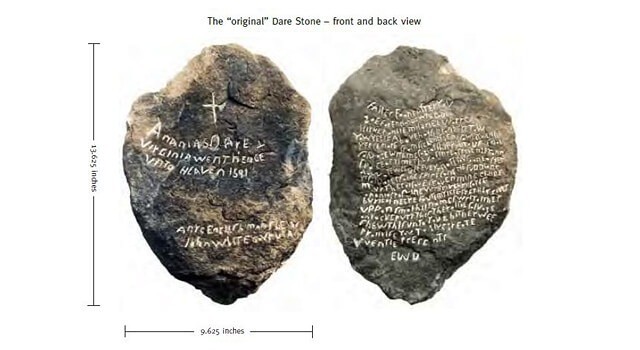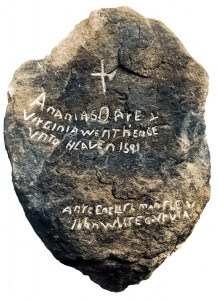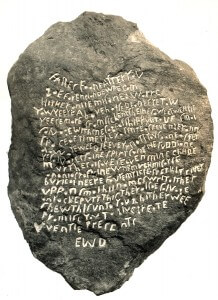Brenau’s Pet Rocks
With focus on the 400th anniversary of America’s first permanent English settlement, interest revived in Brenau’s unique trove of hand-carved rocks that could hold key clues to solving one of the Americas’ greatest mysteries – what happened to ‘The Lost Colony’ of Roanoke. For many, however, the Eleanor Dare Stones remain merely a map to one of the better-played historical hoaxes of all time. Even in infamy, the 2,000 pounds of rocks that have been in Brenau’s possession for seven decades hold an even better story of the nation’s curiosity about her past.
What’s the difference between kidney stones and “The Dare Stones?” Depending on whose they are, kidney stones could have more historical value.
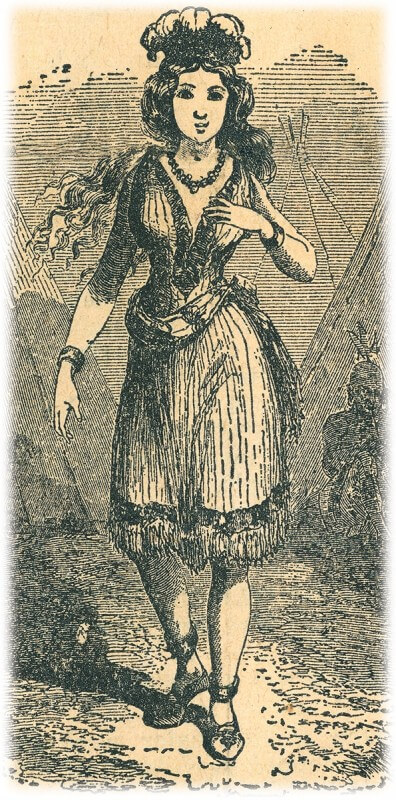
Brenau’s history Professor Jim Southerland, chuckles, but says it’s not a totally fair statement. Over the past three decades Southerland by default became the university’s scholarly voice on the significance of the unique trove of quartz, soapstone and other indigenous southeastern rocks. If nothing else, the stones are relics of one of the biggest hoaxes ever that, in the seven decades since their discovery, have attached a certain historical significance of their own. If they’re what they purport to be, however, they would literally cause the chronicles of the American colonies to be rewritten. With authentication of the stones, Southerland elaborates, “The Lost Colony wouldn’t be lost anymore because we would know what happened to it.”
“The Lost Colony,” of course, refers to the 117 men, women and children that Sir Walter Raleigh recruited in the late 1580s to establish a permanent settlement in the area now known as Virginia and North Carolina, the territory granted to him by the British queen, Elizabeth I. The complement included John White, whom Raleigh had appointed governor, White’s pregnant daughter, Eleanor, and his son-in-law, Ananias Dare. A Raleigh-appointed sea captain, eager to get on with his primary business of piracy, put the colonists ashore, not on the Chesapeake Bay Coast that Raleigh had specified, but on the 18-square-mile Roanoke Island between North Carolina’s Outer Banks barrier islands and the mainland. The next month Eleanor Dare gave birth to a daughter, Virginia, who was the first “English” child born in the New World. Because there was no time for planting crops, Gov. White returned to England for supplies, got his ship commandeered by the British government’s preparations for the imminent Spanish Armada invasion of England, and did not get back to the Americas for almost four years. He found no trace of those he’d left behind – setting off a conundrum that baffled historians, inspired legends, created a multi-million-dollar tourist industry, and – for a time – made, then sullied, the reputation of a tiny, private women’s college in Gainesville, Ga., 560 miles away.
Exaltation and Depression
In November 1937 as America clawed its way out of The Great Depression, a Californian man showed up at the history department of Emory University in Atlanta with a most peculiar object – a 21-pound chunk of rough veined quartz with some foreign looking words chiseled into its surface. The man said he found the rock in a North Carolina swamp, about 80 miles from Roanoke Island, while he was driving through on vacation. The strange stone caught the attention of one of the professors, Dr. Haywood Pearce Jr., who also served as vice president of Brenau, where his father was president. The inscription on the stone read “Ananias Dare & Virginia went hence unto heaven 1591,” and a message to notify John White of that news bore the initials of the author of the carved writing, EWD, presumably those of Eleanor Dare.
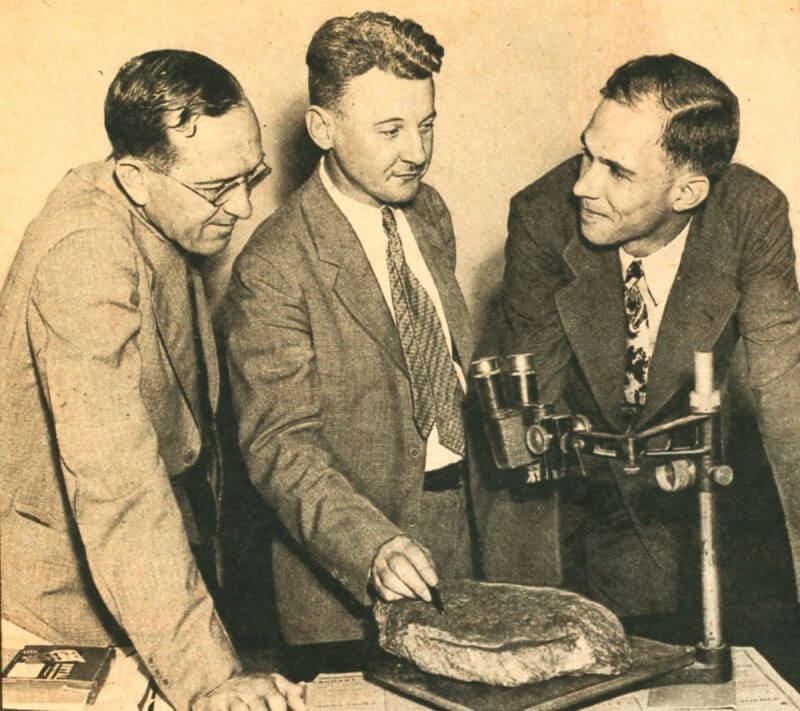
Although Emory’s historians weren’t interested, Pearce and his father certainly were. Perhaps they concluded that, if this chuck of rock indeed marked the graves of America’s “first white child” and her father, it might well be the thing to put their college on the map. They wound up paying the California man $1,000 for the treasure.
Anyone who has used tiller, plow or trowel in Appalachian dirt will swear the region grows rocks. But nothing plows better than cold cash. To make a long story short, over the next four years, similar rocks popped up all over the place, mostly found by four people. Pearce and his father over the years acquired close to 50 of the huge stones, all with similar inscriptions unearthed as far south as the banks of the Chattahoochee River near Atlanta. Although the Pearces’ fervent explorations and money never turned up graves or any other evidence to authenticate the stones, a team of Smithsonian Institution-commissioned historians – headed by the venerable Samuel Eliot Morison of Harvard – traveled to Gainesville and, in a preliminary report, assigned some validity to what had then come to be known as “The Dare Stones.”
The Post Mortem
Everything was good. Pearce Jr. published articles and made speeches. Scores of newspaper and magazine articles trumpeted the Brenau artifacts. There was even talk that Hollywood mogul Cecil B. DeMille was interested in making a movie. Another Brenau professor penned a play about “The Lost Colony” that featured the Dare stones, Pearce Jr. as Sir Walter Raleigh and, as the baby Virginia Dare, Gainesville City Schools’ current Special Assistant to the Superintendent Shirley Whittaker.
“I’m sure the Dare stones were around someplace,” says Whittaker, who as a preschooler had been cast because she took dance and elocution lessons from the play’s author. “But I don’t remember them. I was too busy being impressed by the first real Indians I’d ever seen” – Cherokee tribesmen imported from North Carolina by the Pearces to lend the play more realism.
All that came to an end on April 26, 1941. The Saturday Evening Post, despite its Norman Rockwell covers, was one of the leading muckraking and investigative reporting journals. That day it published an article that systematically razed Brenau’s house of historical stones. The writer, says Southerland, “all but accused Haywood Pearce Jr. of faking the stones himself.”
Although there was talk of libel action against The Post and its New York writer, World War II seemed to put an end to the saga. The Dare Stones mysteriously disappeared from visibility on campus.
Periodically in the past decades interest in the stones comes back to life from time to time. You can see a slightly corpulent, more hirsute Southerland on grainy Internet broadcasts of a 1977 Leonard Nimoy In Search of… TV program in which the Brenau professor proclaims that all but that first stone probably are fakes. In another interview 10 years later he backed off, saying he was “perhaps a little generous” and there’s a “50-50 chance” the first stone is a fake, too. In 1991 historian Robert W. White published A Witness for Eleanor Dare, a book debunking all the debunking and a subtitle proclaiming it to be “the final chapter in the 400-year-old mystery.”
Interest revived again this spring as Jamestown, Va., prepared to celebrate the 400th anniversary of the first English colony to gain purchase in the American soil. Fueled in part by something of an Internet scavenger hunt, one item for which was a rubbing from a Dare stone, dozens of people from around the country began contacting various Brenau officials.
One New Jersey teenager wrote naively that his family descended from the Dares. He wanted to visit Brenau en route to Disney World in Florida. A South Carolina museum asked to borrow a few of the rocks for a special exhibit about myths and legends. A more passionate true believer, Kyle R. Shultz, a 16-year-old Pennsylvanian who says he’s penning a novel about the Roanoke Colony, initially demanded to know why such important artifacts “are kept from the public.” He wrote that, “If my sources are correct, these stones are concealed in an 18th Century mausoleum on the campus.”
Although neither Brenau nor the city of Gainesville and environs existed in the 18th century, technically speaking , most of Brenau’s pet rocks were at the time underground. And they’re protected by “a Jedi.” Their home, however, was not a crypt, but the basement boiler room under the stage of the university amphitheater, the only facility capable of housing 45 rocks that weigh from 20 to 40 pounds each. The “Jedi” caretaker is Jediah Carling, maintenance specialist. One stone is on view at the Northeast Georgia History Center adjacent to the campus. Two – including that first one – are in the special collections section of the Trustee Library. Southerland and Debbie Thompson, campus traditions director, plan to dust the stones off and put them on exhibit by fall semester.
But brace yourselves: the story is about to take a new direction. Part of the Eleanor Dare legend is that she gave birth to another daughter, Agnes, fathered by an American Indian “king” from North Carolina or Georgia where the tribes believed spirits of the dead took up residence in sacred stones.
Kathy Amos, a professional storyteller who is the university’s tradition keeper, points out that Brenau’s resident ghost, named Agnes, didn’t show up on campus until after the Dare stones did.
But let the chills along your spine settle. We’ll save that shaggy rock story for another day.
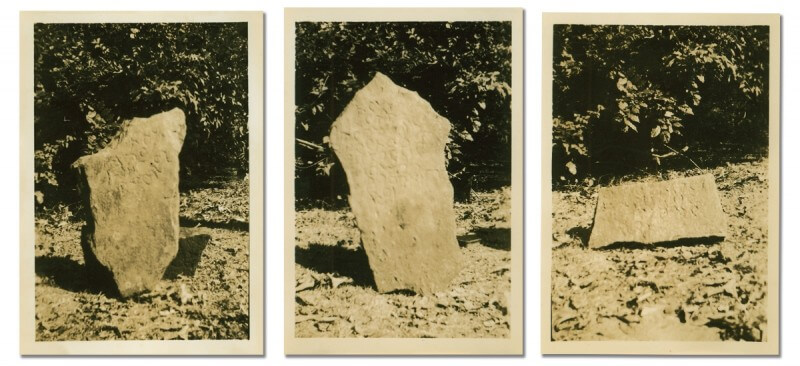
IF YOUR CURIOSITY PORTAL IS STILL OPEN
Check out these Lost Colony/Dare stone resources:
Brenau’s top entertainment rival in the early Dare stone days was the outdoor pageant that has been a tourist attraction on North Carolina’s Outer Banks for decades. http://www.thelostcolony.org/
A Witness for Eleanor Dare, by Robert W. White. This 1991 tome that was to be the final word in proving the historic authenticity of Brenau’s “pet rocks’ is out of print. But you can still find copies online.
http://www.youtube.com/watch?v=LaqG6rC4hIw In Search of…The Lost Colony of Roanoke episode. Narrated by Leonard Nimoy, this 1977 television program features Brenau’s own Dr. Jim Southerland.
The small North Carolina publisher Press 53 just released a new edition of Marjorie Hudson’s Searching for Virginia Dare. Hudson, who researched some of her book at Brenau, draws no final conclusions on the stones’ authenticity, but she doesn’t handle them with kid gloves, either.
